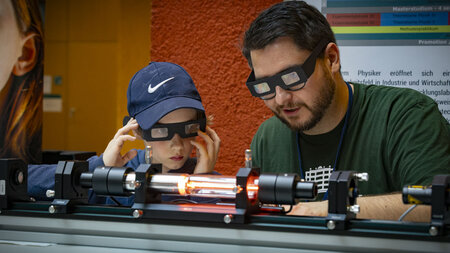Eintrag in der Universitätsbibliographie der TU Chemnitz
Volltext zugänglich unter
URN: urn:nbn:de:swb:ch1-200601242
Henry Alberto, Mendez Pinzon (M.Sc.)
Zahn, Dietrich R.T. (Prof. Dr. Dr. h. c.) ; Esser, Norbert (Prof. Dr.) ; Hietschold, Michael (Prof. Dr.) (Gutachter)
Organic modification of Metal/Semiconductor contacts
Kurzfassung in englisch
In the present work a Metal / organic / inorganic semiconductor hybrid heterostructure (Ag / DiMe−PTCDI / GaAs) was built under UHV conditions and characterised in situ. The aim was to investigate the influence of the organic layer in the surface properties of GaAs(100) and in the electrical response of organic-modified Ag / GaAs Schottky diodes. The device was tested by combining surface-sensitive techniques (Photoemission spectroscopy and NEXAFS) with electrical measurements (current-voltage, capacitance-voltage, impedance and charge transient spectroscopies). Core level examination by PES confirms removal of native oxide layers on sulphur passivated (S-GaAs) and hydrogen plasma treated GaAs(100) (H+GaAs) surfaces. Additional deposition of ultrathin layers of DiMe-PTCDI may lead to a reduction of the surface defects density and thereby to an improvement of the electronic properties of GaAs. The energy level alignment through the heterostructure was deduced by combining UPS and I-V measurements. This allows fitting of the I-V characteristics with electron as majority carriers injected over a barrier by thermionic emission as a primary event. For thin organic layers (below 8 nm thickness) several techniques (UPS, I-V, C-V, QTS and AFM) show non homogeneous layer growth, leading to formation of voids. The coverage of the H+GaAs substrate as a function of the nominal thickness of DiMe-PTCDI was assessed via C-V measurements assuming a voltage independent capacitance of the organic layer. The frequency response of the device was evaluated through C-V and impedance measurements in the range 1 kHz-1 MHz. The almost independent behaviour of the capacitance in the measured frequency range confirmed the assumption of a near geometrical capacitor, which was used for modelling the impedance with an equivalent circuit of seven components. From there it was found a predominance of the space charge region impedance, so that A.C. conduction can only takes place through the parallel conductance, with a significant contribution of the back contact. Additionally a non linear behaviour of the organic layer resistance probably due to the presence of traps was deduced. ( ) ω' R QTS measurements performed on the heterostructure showed the presence of two relaxations induced by deposition of the organic layer. The first one is attributed to the presence of a deep trap probably located at the metal / organic interface, while the second one has very small activation energy ( ~ 20 meV) which are probably due to disorder at the organic film. Those processes with small activation energies proved to be determinant for fitting the I-V characteristics of DiMe-PTCDI organic modified diodes using the expressions of a trapped charge limited current regime TCLC. Such a model was the best analytical approach found for fitting the I-V response. Further improving probably will involve implementation of numerical calculations or additional considerations in the physics of the device.
| Universität: | TU Chemnitz | |
| Institut: | Professur Halbleiterphysik | |
| Fakultät: | Fakultät für Naturwissenschaften | |
| Dokumentart: | Dissertation | |
| Betreuer: | Zahn, Dietrich R.T. (Prof. Dr. Dr. h. c.) | |
| URL/URN: | http://archiv.tu-chemnitz.de/pub/2006/0124 | |
| SWD-Schlagwörter: | Elektrische Prüfung , Schottky-Diode | |
| Freie Schlagwörter (Deutsch): | Charge transient spectroscopy , Current - voltage characterisation , Impedance spectroscopy , NEXAFS on DiMePTCDI , Organic molecules , PES on DiMePTCDI , capacitance - voltage , organic modified diodes , organic-inorganic heterostructures , transport bandgap | |
| DDC-Sachgruppe: | Physik | |
| Tag der mündlichen Prüfung | 10.07.2006 |




